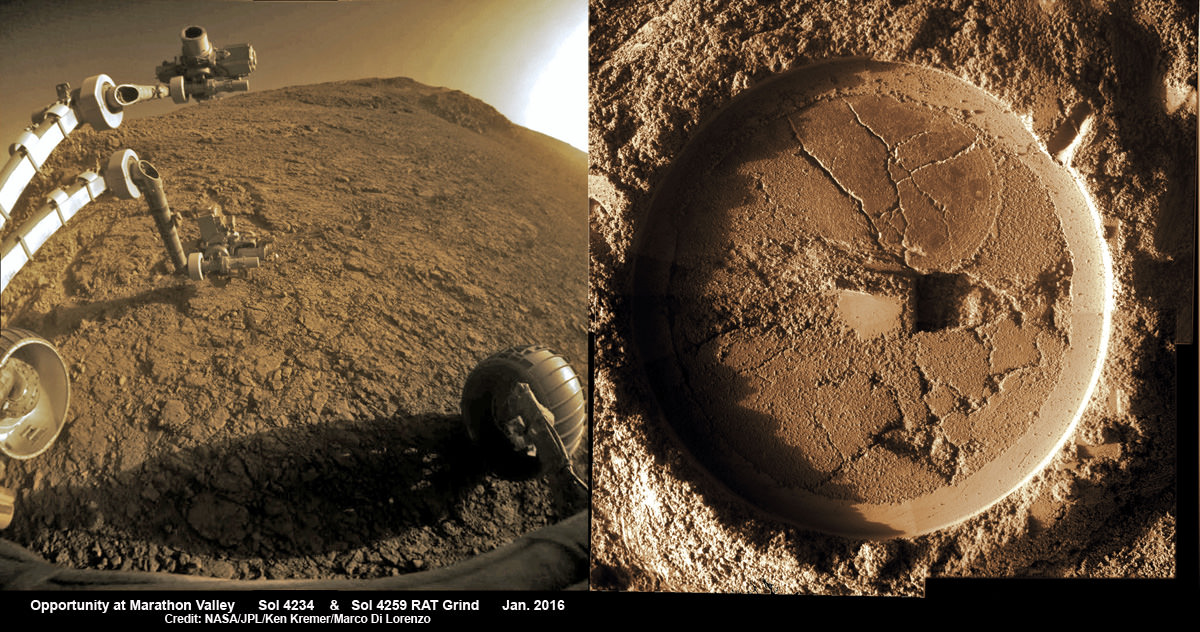
NASA’s world famous Mars Exploration Rover Opportunity continues blazing a daily trail of unprecedented science first’s, still swinging her robotic arm robustly into action at a Martian “Mining Zone” on the 12th anniversary of her hair-raising Red Planet touchdown this week, a top rover scientist told Universe Today.
“Looks like a mining zone!” Opportunity Deputy Principal Investigator Ray Arvidson, of Washington University in St. Louis, explained to Universe Today. On Jan. 24 the rover marked 4267 Sols and a dozen years and counting exploring Mars.
Significantly, Opportunity also just passed through winter solstice on Sol 4246 (Jan. 3, 2016), corresponding to the lowest-solar-energy days of the mission’s seventh Martian winter – 12 years into a 3 month mission.
At this very moment and despite the “low energy” season Opportunity is actively at work, having just completed grinding into a high value rock surface target called “Private John Potts” at her current location inside steep walled Marathon Valley – where she is conducting breakthrough science on smectite clay mineral bearing rocks yielding clues to Mars watery past.
“Just finished multiple grinds on Private John Potts to establish baseline compositions for rocks,” Arvidon told me. “Marathon Valley is unlike anything we have ever seen.”
This is especially exciting to researchers because the phyllosilicate clay mineral rocks formed under water wet, non-acidic conditions that are more conducive to the formation of Martian life forms – billions of years ago when the planet was far warmer and wetter.
“We have been in the smectite [phyllosilicate clay mineral] zone for months, ever since we entered Marathon Valley,” Arvidson confirmed.
See our exclusive mosaic views (above and below) of the Martian worksite at Marathon Valley showing the robotic arm in motion and rock grinding results – created by the imaging team of Ken Kremer and Marco Di Lorenzo.
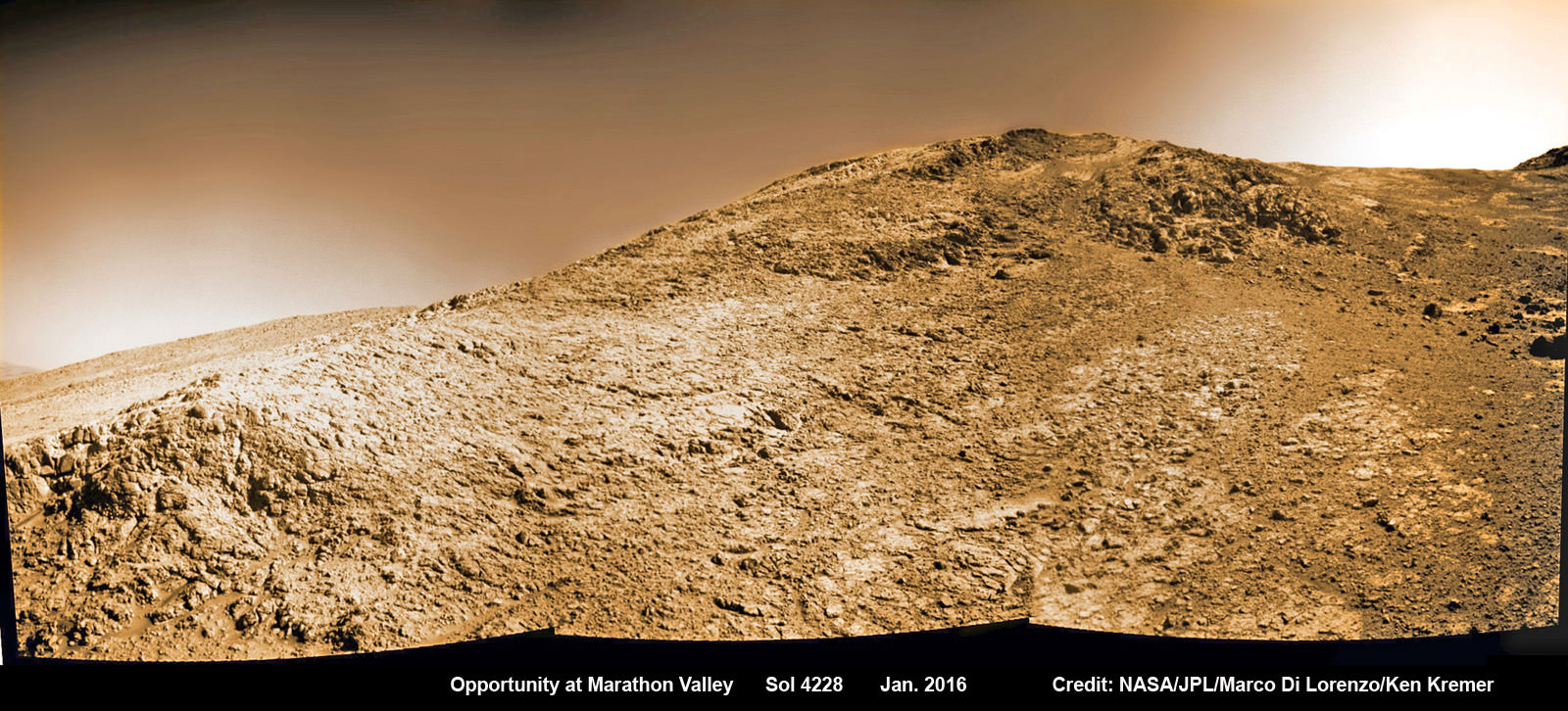
Jan. 24 marks the 12th anniversary since Opportunity’s safe landing on the plains of Meridiani Planum on Jan. 24, 2004, after plummeting through the Martian atmosphere, and surviving the harrowing descent and scorching temperatures dubbed the “Six Minutes of Terror!”
Spirit landed inside 100 mile wide Gusev crater three weeks earlier on Jan. 3, 2004.
Just like her twin sister Spirit, the robotic dynamic duo have experienced an unending series of unimaginable science adventures that ended up revolutionizing our understanding of Mars due to their totally unexpected longevity.
This six wheeled emissary from Earth has survived more than 12 years and 7 frigidly harsh winters on the Red Planet – nearly twice the lifetime of Spirit.
Opportunity has now functioned an unfathomable 47 times beyond her “warrantied” lifetime of merely 90 Martian days, or Sols.
Indeed, after a dozen years sleuthing on Mars, Opportunity ranks as the longest living “Martian.”
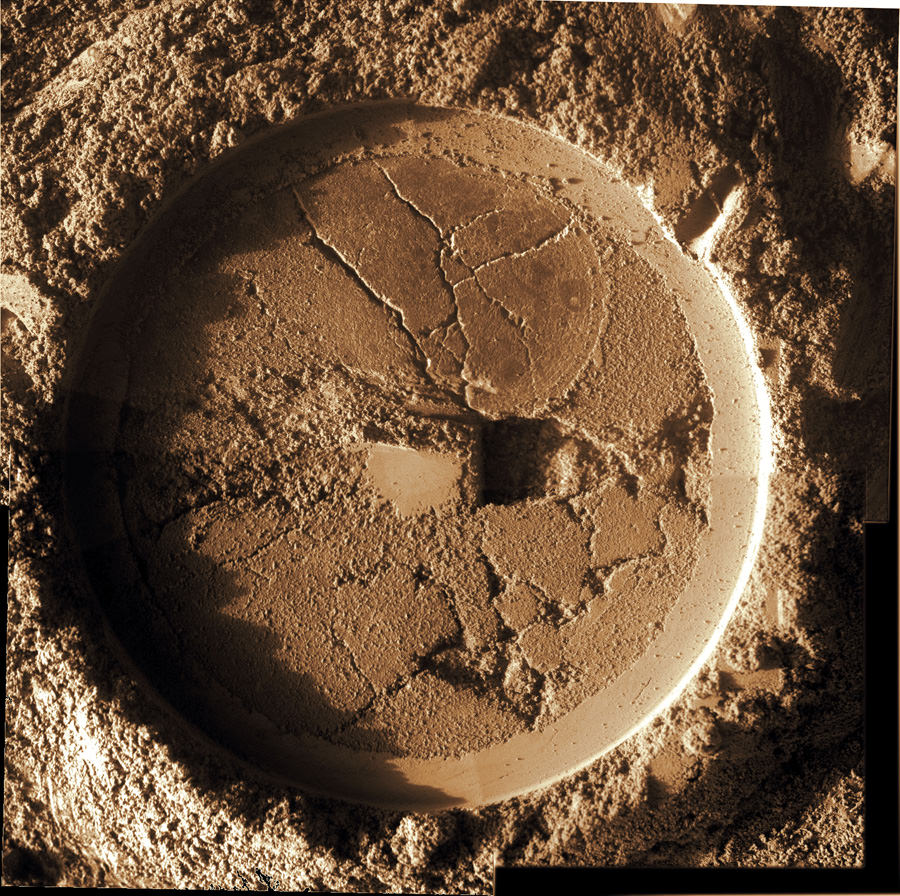
Both rovers were equipped with a rock grinder named the Rock Abrasion Tool (RAT) built by Honeybee Robotics, located on the tool turret at the terminus of the robotic arm. Opportunity’s RAT still functions very well today.
Over the past few weeks, engineers commanded the rovers RAT to first brush and then grind away surface crust from the “Private John Potts” target located on “Knudsen Ridge” inside Marathon Valley.
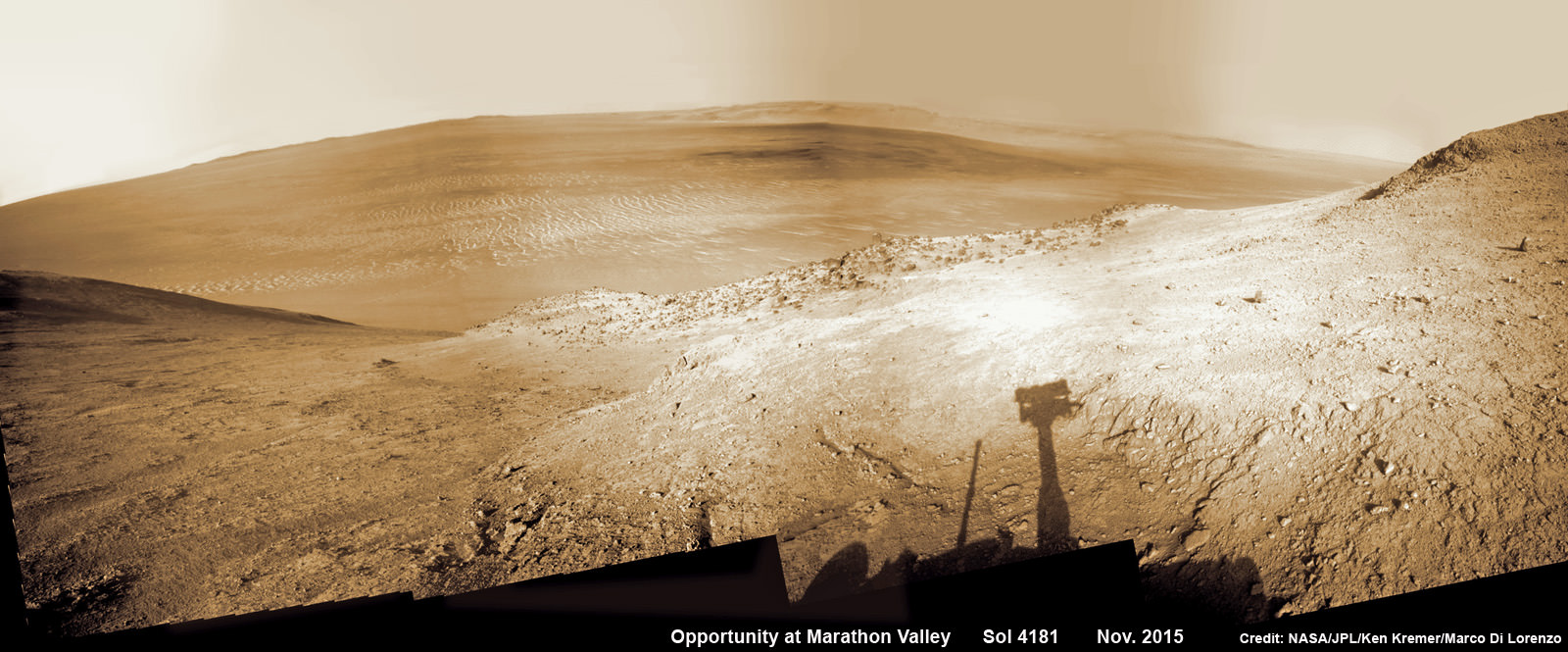
The team is naming targets in Marathon Valley after members of the Lewis and Clark Expedition’s Corps of Discovery. They are also moving the rover from spot to spot to collected as much data as possible to place the region in geologic context and better elucidate Mars history.
Marathon Valley measures about 300 yards or meters long and cuts downhill through the west rim of Endeavour crater from west to east the same direction in which Opportunity is driving. Endeavour crater spans some 22 kilometers (14 miles) in diameter.
Opportunity has been exploring Endeavour since arriving in 2011.
On Sol 4257 (Jan. 14, 2016), the golf cart sized robot successfully finished a series of successive RAT grinds on the target, totaling over 2 millimeters of grind depth to expose the rocks interior. Two days later on Sol 4259, the rover brushed away the grind tailings to enable an in-situ (contact) science campaign to examine the composition and texture of the target.
Opportunity then collected a Microscopic Imager (MI) mosaic and placed the Alpha Particle X-ray Spectrometer (APXS) inside the ground target to gather the measurements for determining the elemental composition of the rock.
The brush, MI and APXS are all housed on the tool turret with the RAT.
With the data gathering done on Sol 4262 (Jan. 19, 2016), the rover was commanded to bump barely 2 inches (5 centimeters) to examine the next target.
“Now finished MI and APXS on John Collin, a small sand splay and today we will button up the IDD [robotic arm] and head east along Knudsen Ridge in search of red outcrops,” Arvidson elaborated.
I asked Arvidson to assess the condition of the RAT’s diamond encrusted bits after 12 years of rock grinds.
“RAT bits still ok because the rocks in Marathon Valley are relatively soft.”
The ancient, weathered slopes around Marathon Valley became a top priority science destination after they were found to hold a motherlode of ‘smectite’ clay minerals, based on data obtained from specially targeted and extensive Mars orbital measurements gathered by the CRISM (Compact Reconnaissance Imaging Spectrometer for Mars) spectrometer on NASA’s Mars Reconnaissance Orbiter (MRO) – accomplished earlier at the direction of Arvidson.
“Opportunity is driving east and southeast down Marathon Valley, bisecting the region in which we detect smectites using CRISM [spectrometer] data,” Arvidson told Universe Today.
Asked to describe what are the key science accomplishments of the past year, Arvidson mentioned the up close inspection of the Marathon Valley smectites, which amounts to a payoff for CRISM’s orbital measurements.
“Discovery of red rocks and complex structures in Marathon Valley,” Arvidson explained. “They are unlike anything we have ever seen. Corresponds to what from CRISM spectra we mapped as smectite bearing.”
“Likely the [smectite] signature is carried by these red rocks in that they have spectral evidence from Pancam for hematite and APXS shows low Fe, Mn and enrichments in Al and Si. Still working on it.”
How did the smectites form?
“Leading hypothesis is hydrothermal alteration just after Endeavour formed. First ground examination of the altered rim of a Noachian crater and many, many Noachian crater rims show evidence of this alteration mineralogy.”

Overall Opportunity remains healthy with sufficient power to continue operations. Indeed the solar arrays output is increasing, producing 454 watt-hours of energy as of Jan. 19, 2016, partly due to more sunshine being available after winter solstice.
In recent weeks, fortuitous wind gusts have blown away some dust obscuring the solar panels and engineers are also maneuvering the rover to north facing slopes to catch more of the sun’s rays on the southern side of Marathon Valley.
“Yes, power has been increasing since we passed aphelion and the winter solstice,” explained Arvidson. “Active but not super active. Batteries do not charge well at cold temperatures so solar power is only one measure of energy available.”
As of today, Sol 4269, Jan. 26, 2016, Opportunity has taken over 207,600 images and traversed over 26.50 miles (42.65 kilometers) – more than a marathon.
Meanwhile Opportunity’s younger sister rover Curiosity traverses and drills into the basal layers at the base of Mount Sharp.
Stay tuned here for Ken’s continuing Earth and planetary science and human spaceflight news.
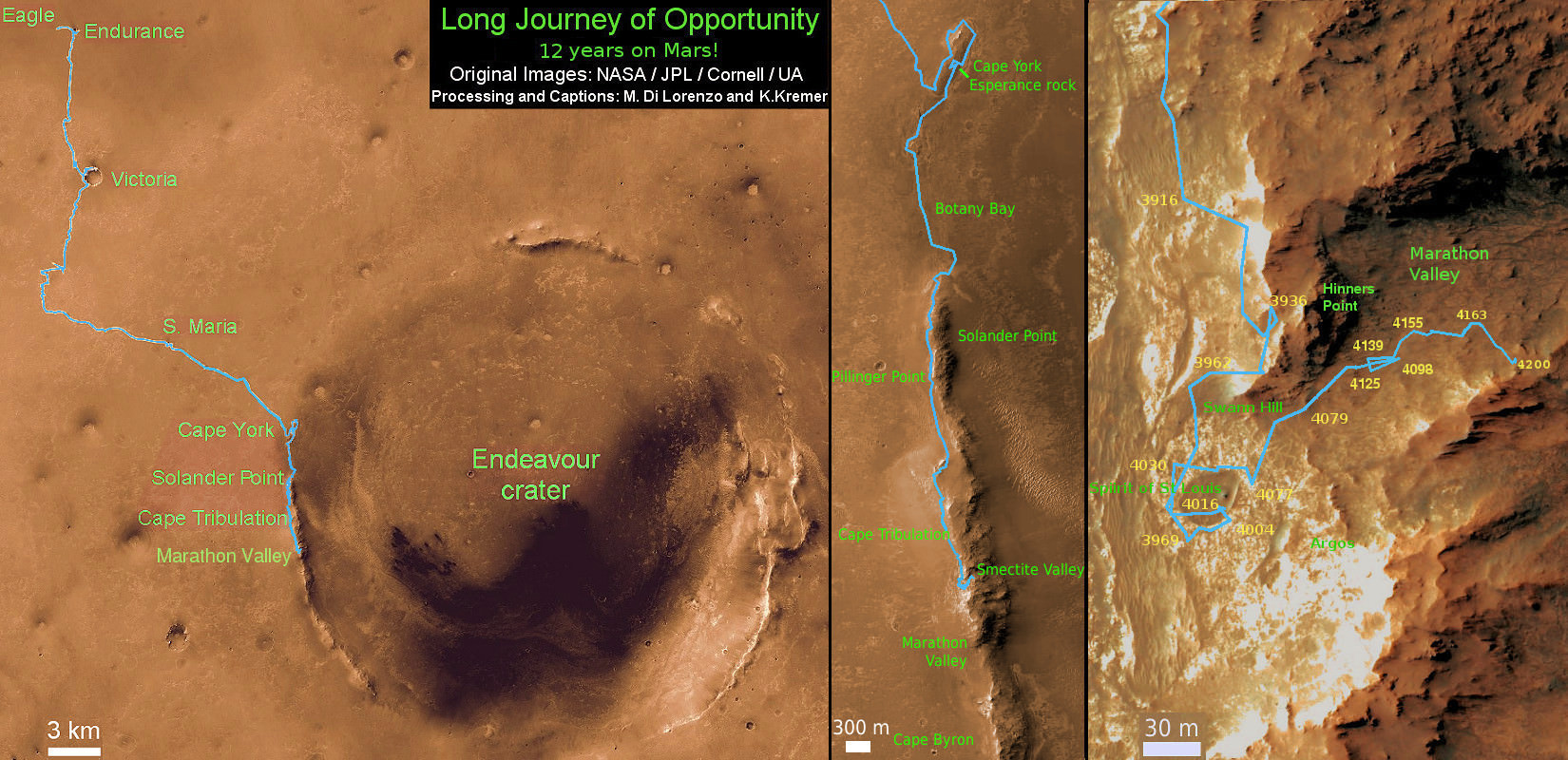

I’m looking forward to Oppy trundling up to the first astronaut on Mars to beg for a head-scratch and a good brush of the solar panels.
Just like NASA. 12 years into a 90 day mission and it’s still not completed. 😉
Yes… Opportunity is almost as robust as your reporting Ken! Next up fossils on Mars!
The comments are suddenly working again.. What did you guys do for the fix?
Happy birthday, Opportunity!